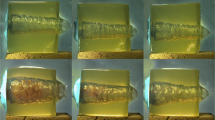Abstract
Background
Suicidal gunshot wounds that are caused by ammunition fired from a 9-mm Luger pistol, with direct contact between the gun muzzle and the victim’s head, present a serious injury pattern even with full metal jacket bullets. Wound ballistic experiments were performed to clarify whether muzzle gases from the firearm have an additional wounding potential.
Methods
Fifteen head models were prepared as follows: an acryl sphere measuring 14 cm in diameter was completely covered with a layer of silicon that was 3 mm thick. These spheres were filled with 10% gelatine. At 4°C, these models were fired at with a 9-mm Luger pistol, loaded with Quick Defense 1 expanding bullets. Five shots were fired with direct muzzle contact, one shot was fired from a distance of 10 cm, four shots were fired from a distance of 2 m, and five shots were fired from a distance of 4 m.
Results
Each projectile penetrated the model; all but one projectile deformed regularly. Each acryl sphere shattered into comminuted pieces but was held together by the silicon cover. The gelatine filling was then cut into slices 1 cm thick, and each slice was optically scanned. An evaluation was performed following both Fackler’s Wound Profile method and the polygon procedure method. The pattern of gelatine disruption did not differ in shots from intermediate ranges, but the amount of gelatine destruction was always more extended in the case of muzzle contact shots. Depending on the section of the bullet path, crack lengths were 31% to 133% longer in contact shots. The first centimetre and the second half of the bullet path showed the greatest increase.
Conclusion
The experimental findings prove the wounding capacity of muzzle gases.







Similar content being viewed by others
References
Schyma C, Madea B (2010) Schussspurensicherung. Praktischer Umgang mit Schuss- und Schmauchspuren. Rechtsmed 20:123–136
Di Maio VJM (1999) Gunshot wounds—practical aspects of firearms, ballistics, and forensic techniques, 2nd edn. CRC Press, New York
Sellier K (1991) Shot range determination. Forensic Science Program 6. Springer, Berlin
Shkrum MJ, Ramsay DA (2007) Close-range firearm wounds. In: Shkrum MJ, Ramsay DA (eds) Forensic science and medicine: forensic pathology of trauma: common problems for the pathologist. Humana Press Inc, Totowa, pp 295–356
Faller-Marquardt M, Bohnert M, Pollak S (2004) Detachment of the periosteum and soot staining of its underside in contact shots to the cerebral cranium. Int J Leg Med 118:343–347
Radford GE (2009) Modelling cranial gunshot wounds and backspatter. Thesis University of Otago Dunedin, New Zealand
Karger B, Nüsse R, Schroeder G, Wüstenbecker S, Brinkmann B (1996) Backspatter from experimental close-range shots to the head. I. Macrobackspatter. Int J Leg Med 109(2):66–74
Thali MJ, Kneubuehl BP, Zollinger U, Dirnhofer R (2002) The “skin–skull–brain model”: a new instrument for the study of gunshot effects. Forensic Sci Int 125:178–189
Zhang J, Yoganandan N, Pintar FA, Guan Y, Gennarelli TA (2007) Experimental model for civilian ballistic brain injury biomechanics quantification. J Biomech 40:2341–2346
Schyma C (2007) Schädelsprengung. Lorei C (ed) Eigensicherung & Schußwaffeneinsatz bei der Polizei: Beiträge aus Wissenschaft und Praxis. Verlag für Polizeiwissenschaft, Frankfurt, pp 129–136
Fackler ML, Malinowski JA (1988) Ordnance gelatin for ballistic studies. Detrimental effect of excess heat used in gelatin preparation. Am J Forensic Med Pathol 9:218–219
Fackler ML, Malinowski JA (1985) The wound profile: a visual method for quantifying gunshot wound components. J Trauma 25:522–529
Schyma C (1998) Die polygonale Modellierung des Schusswundkanals. Eine experimentelle Untersuchung der traumatischen Schusswirkung in Gelatine. Habilitationsschrift, Universität Düsseldorf
Schyma C (2010) Colour contrast in ballistic gelatine. Forensic Sci Int 197(1–3):114–118
Schyma C, Madea B (2011) Evaluation of the temporary cavity in ordnance gelatine. Forensic Sci Int; Epub ahead of print. doi:10.1016/j.forsciint.2011.07.021
Verhoff MA, Karger B (2003) Atypical gunshot entrance wound and extensive backspatter. Int J Leg Med 117(4):229–231
Lieske K, Janssen W, Kulle KJ (1991) Intensive gunshot residues at the exit wound: an examination using a head model. Int J Leg Med 104:235–238
Große Perdekamp M, Arnold M, Merkel J, Mierdel K, Braunwarth R, Kneubuehl BP, Pollak S, Thierauf A (2011) GSR deposition along the bullet path in contact shots to composite models. Int J Leg Med 125:67–73
Karger B (1995) Penetrating gunshots to the head and lack of immediate incapacitation. II. Review of case reports. Int J Leg Med 108(3):117–26
Buyuk Y, Cagdir S, Avsar A, Duman GU, Melez DO, Sahin F (2009) Fatal cranial shot by blank cartridge gun: two suicide cases. J Forensic Leg Med 16(6):354–6
Frank M, Franke E, Philipp KP, Bockholdt B, Ekkernkamp A (2009) Ballistic parameters of cal. 9 mm × 17 mm industrial blank cartridges (cattle cartridges). Forensic Sci Int 192(1–3):83–87
Acknowledgments
We would like to thank Mr. Roland Klotz of the Institute of Forensic Medicine Homburg/Saar for his loyal help and high-precision shooting and also Miss Silvie Rauen for her assistance.
Author information
Authors and Affiliations
Corresponding author
Rights and permissions
About this article
Cite this article
Schyma, C. Wounding capacity of muzzle-gas pressure. Int J Legal Med 126, 371–376 (2012). https://doi.org/10.1007/s00414-011-0641-y
Received:
Accepted:
Published:
Issue Date:
DOI: https://doi.org/10.1007/s00414-011-0641-y




